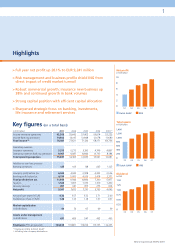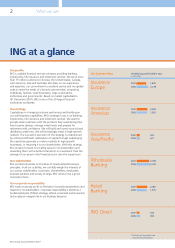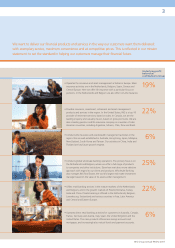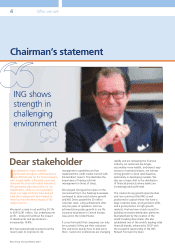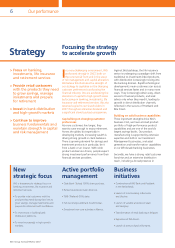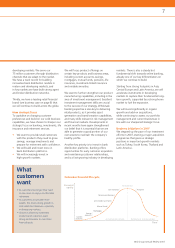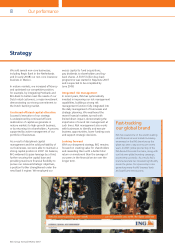ING Direct 2007 Annual Report Download - page 13
Download and view the complete annual report
Please find page 13 of the 2007 ING Direct annual report below. You can navigate through the pages in the report by either clicking on the pages listed below, or by using the keyword search tool below to find specific information within the annual report.
Insurance Europe 19
Insurance Americas 22
Insurance Asia/Pacific 6
Wholesale Banking 25
Retail Banking 22
ING Direct 6
Total 100
business, notably at ING Direct, ING Real
Estate and Retail Banking activities in
developing markets. Recurring underlying
operating expenses in mature businesses
increased 2.6%. The underlying cost/
income ratio deteriorated to 65.2% from
63.5% in 2006 as a result of the
investments in growth businesses.
Returns remained high with the underlying
RAROC after tax at 22.3%, up from 20.5%
in 2006, reflecting lower tax charges.
ASSET MANAGEMENT
Assets under management increased
EUR 36.9 billion (6.1%) to EUR 636.9 billion
in 2007. Growth was driven by a net inflow
of EUR 40.4 billion. For more detail see the
Asset management section (page 26).
LOOKING FORWARD
ING’s capital position is strong, particularly
after the introduction of Basel II, and ING
is entering 2008 in a position of strength
with strong business fundamentals driving
commercial growth. The operating
environment is likely to remain challenging
going forward, as the economic uncertainty
and market volatility has not come to an
end yet. Creating value for shareholder
remains paramount, and ING has proven
its commitment to enhance shareholder
returns through an attractive increase in
dividends and the ongoing EUR 5.0 billion
share buy-back.
For a full report on the financial highlights,
see the 2007 ING Group Annual Report
and Annual Accounts.
CAPITAL MANAGEMENT
In 2007, we enhanced our strong capital
position thanks to the robust profitability
of the business and good capital
management measures. We used excess
capital to fund significant organic growth,
make acquisitions, buy back shares, and
pay attractive dividends to shareholders.
On balance, ING widened its spare leverage
by a third, further securing our capital base
and providing maximum financial flexibility
to pursue strategic objectives.
Strong capital position
The capital position of ING Group remained
robust during 2007, with all major capital
ratios by year-end within targets consistent
with the Group’s AA– rating target.
We worked to finalise preparations for
Basel II, guidelines that determine the
minimum capital a bank must put aside
to offset unexpected losses. Our Basel II
indicative Tier-1 ratio of approximately
9.9% and total BIS ratio of 13.8% compare
very favourably to our capital ratios under
Basel I, reflecting the moderate risk in ING
Bank’s balance sheet, mainly thanks to our
large mortgage portfolio. We intend, over
the coming years, to bring the capital ratios
back down to their existing targets. The
additional Tier-1 capital available under
Basel II is approximately EUR 7 billion.
Capital adequacy
The main task of the Group Capital
Management function is to monitor,
manage and plan the capital adequacy of
ING Group, ING Bank and ING Insurance,
and to execute all related capital market
transactions. A centralised capital
management is vital to create maximum
financial flexibility to pursue strategic
objectives and withstand financial stress,
and ensure the various requirements of
shareholders, regulators, rating agencies
and internal economic capital models can
be properly balanced.
ING endeavours to employ its capital in the
most optimal way. It is therefore important
that business units are incentivised to
hold only the capital they need to support
the risks in their business and can count
on capital injections so their business can
grow profitably.
Many ING insurance businesses need to
hold more capital than their economic
capital due to regulatory and/or rating
agency constraints. However, free surplus
(capital not being employed as economic
capital) not so constrained can be used
elsewhere to deliver further profitable
growth. During 2007, EUR 5.8 billion of
dividends were paid by ING Insurance
Netherlands back up to Group level, where
it can be strategically deployed to where it
can help deliver further growth.
Share buy-back
We foresaw that, without further
intervention, significant excess capital
would continue to build during 2007.
We therefore decided to carry out a
EUR 5 billion share buy-back, spread
over a year from June 2007. By year-end,
90.7 million shares had been repurchased
for EUR 2.8 billion. Once completed,
the share buy-back will improve EPS by
around 7%.
Capital Management was also involved
in the repurchase of the ING preference
shares of both Fortis and ABN AMRO
during 2007, following repurchase of
Aegon’s preference shares in 2006. All
three major holders have now sold their
ING preference shares back to ING Group.
Acquisitions and divestments
For the first time in many years, 2007 saw
significant acquisition and divestment
activity, including two major acquisitions:
Oyak Bank in Turkey and pension fund
businesses in Latin America for a total
cost of EUR 2.5 billion.
Contribution business lines 2007 underlying profit before tax
in percentages
11
ING Group Annual Review 2007


